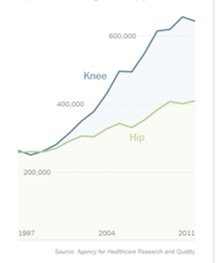Knee Replacement Cost: Prices Soar as the Outcomes Drop and the Complications Mount
What does a knee replacement cost? There was a great New York Times article on Sunday that reported that patients without insurance (and some with insurance), as being priced out of knee or hip replacement surgeries. One of the issues brought up is that the cost of a knee or hip device is controlled by monopolistic pricing. Basically, a “cartel” of five companies manufacture these devices. The sales rep and then hospital mark up these devices so that the final cost to the insurance company can be anywhere from $25-40,000. Unlike other areas of the economy, where having five companies all manufacturing the same thing would mean low prices, a combination of financial ties to surgeons, anti-competitive behavior, regulation and health insurance have kept these prices very high. Even if you decide to pay cash, the story points out that an implant that costs $150 in Asia will cost $13,000 here.
The story also compares U.S. and European prices for knee and hip replacements. Many patients are traveling to Europe, where the socialized medicine system pushes down cash prices. The NY times article compares the cost of a hip replacement surgery in Belgium ($13,600) to a knee replacement in the U.S. ($125,000). My take is obviously different (who knew?) Even if you can get a new joint in Europe of Asia for $10-20,000, why would you want one to? As discussed in prior blogs, they are associated with wear particles which can spike metal levels in the blood, huge increases in heart attack and stroke risk, wearing out at fast rates in active people, and the outcomes aren’t as good as usually advertised. In fact, you may want to take a look at how the RegenexxSD stem cell procedure compares to knee and hip replacements. For knees, the same day stem cell procedure held it’s own based on the same standardized orthopedic measures used in both groups. For hips, the stem cell procedure, considering it was an injection versus a joint amputation, also did well.
The upshot? U.S. healthcare is very expensive. As I have blogged before, as a country, we have missed a huge opportunity to fix our cost problem by not turning the healthcare market into a consumer driven model. This New York Times article highlights that issue. In the meantime, with huge amounts in co-pays, deductibles, or cash for invasive and risky surgeries that have huge side effects, hip and knee replacement cost and complications soar as good outcomes drop. Why take that route to begin with when some patients are treating their arthritis through a simple injection?

NOTE: This blog post provides general information to help the reader better understand regenerative medicine, musculoskeletal health, and related subjects. All content provided in this blog, website, or any linked materials, including text, graphics, images, patient profiles, outcomes, and information, are not intended and should not be considered or used as a substitute for medical advice, diagnosis, or treatment. Please always consult with a professional and certified healthcare provider to discuss if a treatment is right for you.

